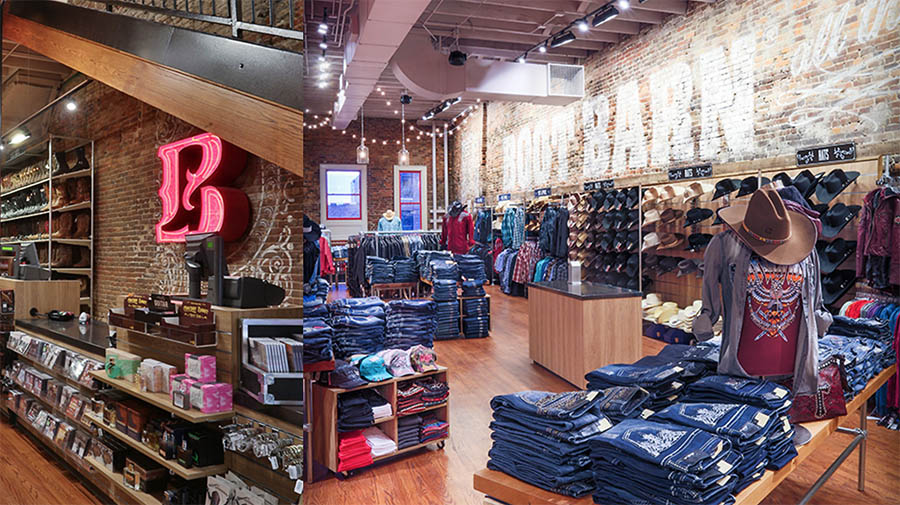Boot Barn Holdings Inc. reported net earnings fell 34.5 percent in the fourth quarter ended March 28. Sales decreased 2.1 percent.
For the year, net income increased to $47.9 million, or $1.64 per diluted share, compared to $39.0 million, or $1.35 per diluted share in the prior-year period. Revenues increased 8.8 percent.
Jim Conroy, chief executive officer, commented, “These are difficult times and our hearts go out to those who are suffering as a result of the COVID-19 crisis. Over the past two months, our primary focus has been on protecting our employees and safely providing our customers with the essential products they need to support our nation during this unprecedented situation. The majority of our stores have remained open, as most jurisdictions have recognized Boot Barn as a business that provides boots and apparel to those working in essential industries.”
Conroy continued, “From a financial perspective, in mid-March we were expecting to conclude another solid quarter with results tracking within our guidance range. However, as a result of COVID-19 and stay-at-home directives, our business slowed dramatically. Same-store sales turned negative, declining 8 percent in the third week of fiscal March and more than 50 percent during the final two weeks of the quarter. While business in April continued to be significantly negative, we have seen a sequential steady increase in sales every week since the end of March, potentially driven in part by our customers receiving government stimulus payments. While the majority of our stores remain open, they are operating at reduced hours and are experiencing significant declines in traffic. This headwind has been partially offset by an acceleration in demand on our e-commerce sites. Despite these challenging times, I am confident that we will emerge from this crisis well positioned to resume our momentum and deliver against our long-term financial objectives.”
COVID-19 Update
As described in a Current Report on Form 8-K filed with the Securities and Exchange Commission on April 9, 2020, COVID-19 has impacted the company through store closures and decreased store traffic. Below is a summary of the current status of the company’s stores and the actions taken to mitigate the financial impact of COVID-19 and preserve liquidity to-date.
- Store Operations — The company has remerchandised the stores, prioritizing essential products for critical workers, streamlined the stores to enable customers to get in and out of the store quickly, and augmented the assortment. The company has worked with authorities, municipalities, and law enforcement in order to comply with local health and safety regulations where stores are open for business. As of May 19, 2020, 242 of the 260 Boot Barn stores are open.
- Board of Directors and Executive Compensation — The company’s Board of Directors has agreed to waive the current quarter’s payment of their cash retainer fee. The company’s Chief Executive Officer, senior leadership team and other members of management have significantly reduced their salaries.
- Distribution Centers — To help ensure the well-being of its associates, the company has put enhanced safety protocols in place, including temperature checks, strict social distancing, hand sanitizer in all areas, and heightened cleaning of the facilities in accordance with CDC guidelines.
- Expense Saving Measures —As a result of decreased traffic in the stores, the company has reduced its hours of operations and the hours of its store associates. The company has also temporarily furloughed a significant number of employees at its central office location, distribution centers, and stores.
- Credit Facility and Cash Position — As of March 28, 2020, the company had $35.1 million of availability remaining on its $165.0 million line of credit and $69.6 million of cash on hand.
- Capital Expenditures and Cash Management— The company is intently focused on cash savings as it partners with its vendors on the timing of cash payments. It has also suspended most of its capital expenditures and delayed the opening of many new stores.
Operating Results For The Fourth Quarter Ended March 28, 2020
- Net sales decreased 2.1 percent to $188.6 million from $192.8 million in the prior-year period. Consolidated same-store sales decreased 4.7 percent with retail store same-store sales down 7.1 percent and e-commerce same-store sales up 7.5 percent. Same-store sales growth was solid during the first 10 weeks of the quarter before declining significantly during the last three weeks, primarily as a result of decreased traffic in our stores that resulted from store closures and customers staying at home in response to the COVID-19 crisis.
- Gross profit was $58.0 million, or 30.7 percent of net sales, compared to $63.4 million, or 32.9 percent of net sales, in the prior-year period. Gross profit decreased primarily due to decreased sales resulting from the COVID-19 crisis. The decrease in gross profit rate of 220 basis points was driven by 210 basis points of deleveraging in buying and occupancy costs and a 10 basis point decline in merchandise margin rate. The deleverage in buying and occupancy costs was primarily a result of lower volume sales. Merchandise margin declined 10 basis points as a result of higher shrink when compared to lower than normal shrink in the prior-year period and higher outbound freight resulting from growth in e-commerce sales penetration as a percentage of sales. These increases more than offset the product margin expansion from increased exclusive brand penetration and more full-price selling.
- Selling, general and administrative expenses were $48.3 million, or 25.6 percent of net sales, compared to $46.9 million, or 24.3 percent of net sales, in the prior-year period. The increase in selling, general and administrative expenses was primarily a result of additional expenses for both new and acquired stores and COVID-19-related expenses. Selling, general and administrative expenses as a percentage of sales increased by 130 basis points as a result of deleveraging from lower sales and COVID-19-related expenses in the current-year period.
- Income from operations decreased 41.2 percent to $9.7 million, or 5.1 percent of net sales, compared to $16.5 million, or 8.6 percent of net sales, in the prior-year period. This decline in income from operations is a result of the negative impact on sales, gross margin and selling, general and administrative expenses due to the COVID-19 crisis.
- Net income was $5.7 million, or $0.20 per diluted share, compared to $8.7 million, or $0.30 per diluted share in the prior-year period. Net income per diluted share in the current-year period includes a $0.01 per share benefit due to income tax accounting for share-based compensation and a $0.01 per share benefit from the realization of a state tax operating loss. Net income per diluted share in the prior-year period includes $0.02 per share of tax expense related to a return to provision adjustment. Excluding the tax adjustments in both periods, net income per diluted share was $0.18, compared to $0.32 in the prior-year period.
Operating Results For The Fiscal Year Ended March 28, 2020
- Net sales increased 8.8 percent to $845.6 million from $776.9 million in the prior-year period. Consolidated same store sales increased 5.0 percent with retail store same store sales up 4.5 percent and e-commerce same store sales up 7.4 percent. The increase in net sales was driven by the increase in same store sales and sales from stores added over the past twelve months, partially offset by the significant decline in net sales in the final three weeks of the fiscal year due to the COVID-19 crisis.
- Gross profit was $276.5 million, or 32.7 percent of net sales, compared to $251.4 million, or 32.4 percent of net sales, in the prior-year period. Gross profit increased primarily due to increased sales and an increase in merchandise margin rate. The 30 basis point increase in gross profit rate was driven by a 90 basis point increase in merchandise margin rate, partially offset by 60 basis points of deleverage in buying and occupancy costs. Growth in exclusive brand penetration and more full price selling fueled the improvement in merchandise margin. The deleverage in buying and occupancy costs was driven primarily by the addition of personnel in our product design and development team.
- Selling, general and administrative expenses were $202.8 million, or 24.0 percent of net sales, compared to $187.1 million, or 24.1 percent of net sales, in the prior-year period. The increase in selling, general and administrative expenses was primarily a result of additional costs to support higher sales and expenses for both new and acquired stores. Selling, general and administrative expenses as a percentage of sales decreased by 10 basis points as a result of expense leverage on higher sales.
- Income from operations grew 14.5 percent to $73.7 million, or 8.7 percent of net sales, compared to $64.3 million, or 8.3 percent of net sales, in the prior-year period. This increase represents approximately 40 basis points of improvement in operating profit margin.
- Net income was $47.9 million, or $1.64 per diluted share, compared to $39.0 million, or $1.35 per diluted share in the prior-year period. Net income per diluted share in the current-year period includes a $0.07 per share benefit due to income tax accounting for share-based compensation and a $0.01 per share benefit from the realization of a state tax operating loss. Net income per diluted share in the prior-year period includes a $0.13 per share benefit due to income tax accounting for share-based compensation and $0.02 per share of tax expense related to a return to provision adjustment. Excluding the tax adjustments in both periods, net income per diluted share was $1.56, compared to $1.24 in the prior-year period.
Current Business
In the seven weeks quarter-to-date period, same-store sales are down 30 percent. In-store sales are down 49 percent whole online sales are ahead 60 percent. In the four weeks of fiscal April, same-store sales were down 45 percent. In-store sales were down 64 percent while online sales were ahead 45 percent. In the first three weeks of fiscal May, same-store sales were down 14 percent. In-store sales were down 31 percent while online sales were ahead 72 percent.
Fiscal Year 2021 Outlook
The COVID-19 crisis continues to adversely affect the company’s results. Due to the ongoing uncertainty created by COVID-19, the company is not providing first quarter and fiscal year 2021 guidance at this time.
Boot Barn operates 260 stores in 35 states, in addition to an e-commerce channel bootbarn.com.
Photo courtesy Boot Barn















